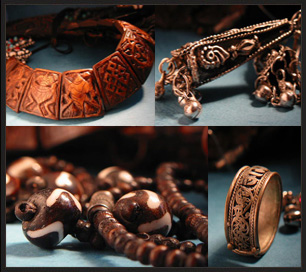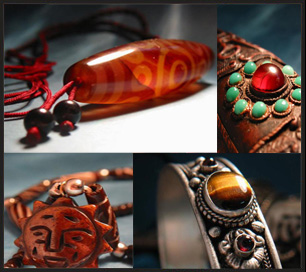|
Tibet Artwork, Tibetan Silver Jewelry , Tibetan Jewelry, Tibet Jewelry, Jewelry from Tibet, Tibetan Buddhist Jewelry, Tibetan Turquoise Jewelry, Tibetan Jewelery
Tibet Artwork, Tibetan Silver Jewelry , Tibetan Jewelry, Tibet Jewelry, Jewelry from Tibet, Tibetan Buddhist Jewelry, Tibetan Turquoise Jewelry, Tibetan Jewelery, Buddhist Jewelry
|
White color is thought to have a very cold quality, as in snow, or an extremely hot quality, such as a burning metal. Either one can be life threatening and reminds us of death and the end of things. Fittingly, therefore, the goddess Tara in her form which grants longevity to worshippers is depicted as white hued (White Tara). She also denotes purity, holiness and cleanliness and is 'the one who leads out beyond the darkness of bondage'.
White is a color that both incorporates, and set things apart from the rainbow spectrum of everyday life.
The color white appears in numerous Buddhist episodes, one of the most well known being the birth of Buddha. Legend states that Queen Maya, mother of Buddha dreamt of a white elephant that flew through the air and touched her right side with its trunk. Now elephants are well known for their strength and intelligence, and are also associated with gray rain clouds and fertility. Indeed rainwater means that the seeds will be able to germinate and vegetative life will be able to spring forth.
The white color of the majestic animal adds to this narrative an element of purity and immaculacy. In his former lives the Buddha had been an elephant several times, as mentioned in the Jatakas, or tales of his previous births. The white elephant is believed to have been the future Buddha himself who descended from heaven so that he could be born. It thus also represents for queen Maya a chaste birth, or the element of the triumph of spirit over the flesh.
|
Buddhist Symbols
In the earliest centuries of Buddhism, statues of the Buddha were not used. Instead, Buddhist art consisted of images symbolizing the Buddha and his teachings, such as the lotus, the Wheel of the Law, the Bodhi tree and the Buddha's footprints.
Eventually, the Buddha image became one of the most popular representations in Buddhism, but these early symbols remain important and are frequently used to this day. They are especially important in Theravada Buddhist countries like Sri Lanka and Thailand.
As Buddhism spread, Buddhist symbolism was enriched by the cultures it came into contact with. This is especially true of Buddhism in Tibet, which has developed a rich symbolic tradition. The central symbols of Tibetan Buddhism are the Eight Auspicious Symbols, known in Sanskrit as Ashtamangala (ashta meaning eight and mangala meaning auspicious). The Eight Auspicious Symbols are printed on Tibetan prayer flags, incorporated into mandalas and thangkas, and used in other forms of ritual art. Another important symbol is the Wheel of Life, a symbolic representation of the universe as understood by Tibetan Buddhists.
Other important types of symbolism in Buddhism include colors, especially the five colors of white, yellow, red, blue and green, and symbolic hand gestures called mudras. The articles in this section explore these Buddhist symbols, providing information on their history, meaning and use in Buddhism today. (For an introduction and quick guide to Buddhist colors, see our Chart of Buddhist Color Symbolism.)
|
|




添加新评论